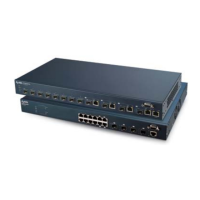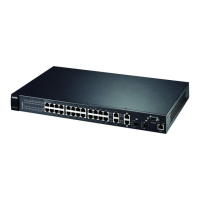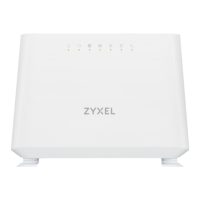Ethernet Switch CLI Reference Guide
45
CHAPTER 9
Classifier Commands
Use these commands to classify packets into traffic flows. After classifying traffic, policy
commands (Chapter 43 on page 147) can be used to ensure that a traffic flow gets the
requested treatment in the network.
9.1 Command Summary
The following section lists the commands for this feature.
Table 25 Command Summary: classifier
COMMAND DESCRIPTION M P
show classifier [<name>] Displays classifier configuration details. E 3
classifier <name> <[packet-
format <802.3untag|802.3tag|
EtherIIuntag| EtherIItag>]
[priority <0-7>] [vlan <vlan-
id>][ethernet-type <ether-
num|ip|ipx|arp|rarp|
appletalk|decnet|
sna|netbios|dlc>] [source-mac
<src-mac-addr>] [source-port
<port-num>] [destination-mac
<dest-mac-addr>] [dscp <0-63>]
[ip-protocol <protocol-
num|tcp|udp|icmp|egp|
ospf|rsvp|igmp|igp|pim|ipsec>
[establish-only]] [source-ip
<SRC-IP-ADDR> [mask-bits <mask-
bits>]] [source-socket <socket-
num>] [destination-ip <dest-ip-
addr> [mask-bits <mask-bits>]]
[destination-socket <socket-
num>] [inactive]>
Configures a classifier. Specify the parameters to identify the
traffic flow:
ethernet-type - enter one of the Ethernet types or type the
hexadecimal number that identifies an Ethernet type (see
Table 26 on page 46)
ip-protocol - enter one of the protocols or type the port
number that identifies the protocol (see Table 27 on page 46)
establish-only - enter this to identify only TCP packets
used to establish TCP connections.
source-socket - (for UDP or TCP protocols only) specify
the protocol port number (see Table 28 on page 46).
destination-socket - (for UDP or TCP protocols only)
specify the protocol port number (see Table 28 on page 46).
inactive - disables this classifier.
C13
no classifier <name> Deletes the classifier.
If you delete a classifier you cannot use policy rule related
information.
C13
no classifier <name> inactive Enables a classifier. C 13

